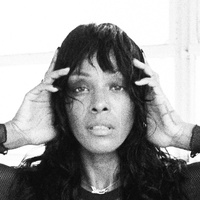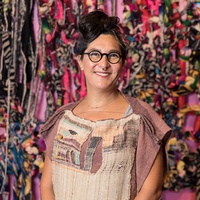As told to Max Freedman, 2944 words.
Tags: Music, Art, Beginnings, Success, Adversity, Politics.
On being fearless in your creative practice
John Carlin of the HIV/AIDS nonprofit Red Hot discusses funneling anger and activism into creativity, abandoning the idea of success, and acting on the opportunities in front of you.How does your creativity fuel how you assemble and promote Red Hot’s albums and otherwise work with musicians?
I started my career in my twenties as a curator. I worked at the Whitney Museum. I curated shows for a lot of East Village galleries, and that’s what I wanted to do.
The word “curation” has now become a cliche in the internet space, but this was formal training in the creativity of coming up with a concept, either organizing it around certain artists or borrowing artwork in different scenes, and presenting an experience to the public. I’ve always thought that the Red Hot albums come out of that and that they’re curated. They’re not just random compilation albums. They have themes. The types of artists are chosen in a very specific way, and the mix of artists, the flow of the records, the artwork, branding, the whole thing.
I think it’s creative to turn your curation into a way to raise money for HIV/AIDS relief. Can you talk about how you got over any fears of failure with that, and any anxieties about it being out of the box?
When I started this, I was so young, and I was so mad about what was going on in terms of LGBTQ+ rights, the HIV crisis, that fear and anxiety weren’t really part of it. I just jumped in.
I had been inspired by a lot of artists and activists. That’s the other side of the coin, that the curation, being in the art world, was how I got exposed to a lot of friends dying of AIDS, but also AIDS activism. I knew Keith Haring, David Wojnarowicz, and other people that were part of the so-called East Village art scene. I knew these people before they became famous. I should have been totally terrified, but I wasn’t. I was just angry.
How did Keith and David influence your work? What did you learn from them as they became more prominent?
What I learned from David, who I knew very well and worked with for many years, was how you combine art and activism. It wasn’t something I had really thought about.
I was really interested in pop culture, and I curated an exhibition at the Whitney called “The Comic Art Show” that combined original comic strips and comic book art with fine art paints. It was Jasper Johns, Warhol, Chester Gould, and George Herriman, who did Krazy Kat. … I also put Keith in the show. I think it was the first major American museum show to include graffiti street art.
I was coming more from an art school perspective, and David and Sue Coe really triggered something in my brain: Art can be about something. It’s really important to have substance, and it can be about social issues, and that inspired me.
Keith was inspiring because of his energy and the way he and a bunch of other people at that time reinvented pop art. It seemed like a thing from the past, very static, very elitist even though it was popular imagery. [It was] done in such a stark, minimalist way, whereas Keith, [Jean-Michel] Basquiat, and a bunch of other people made it feel down to earth, like it was about the world and living.
After Keith and David died of AIDS, to what extent did that further fuel your fire or, conversely, make you feel hopeless?
I guess I should’ve felt hopeless, but I really didn’t. I felt like they were fallen comrades, and it was my obligation to continue the fight in their name. I feel like that to this day. I feel like I’m one of the people who survived that terrible era that started out with such hope and promise and ended up with sickness and death for many creative people in New York.
I often think about, what would the world be like if my generation had survived, and what would be different? And then, I try to act on it, not just for Red Hot, but also in the commercial work I’ve done, particularly on the internet. During the early days of the internet, I kept feeling like, “What would Keith, David, Basquiat, and all those people do with the internet, content online, social media?” That was more inspiring to me than—obviously, there’s a lot of sadness. It’s hard to go back to that era. The way I deal with it is, I just keep looking forward, thinking about what’s next.
Would you say thinking about what’s next is more of a distraction from the grief, more continuing to work in memoriam of the folks you’ve lost, or both?
I would say it’s the latter. One thing I, and other people, learned from the AIDS crisis is a phrase that David used a lot, and it’s a cliche but so true: “Smell the flowers while you can.” Since that era, I’ve just tried to be very mindful. What a blessing that I get to make these records, work with all these creative artists 30-plus years later, and still have the energy and inspiration to do it. In some ways, it’s positive.
I’m 30, so I grew up in an era where we have PrEP and PEP, and some folks in my generation thus wrongly think that the HIV/AIDS epidemic is over. Amid this misconception, have you encountered a decreased interest in what Red Hot does? If so, how do you stay inspired amid this?
We’ve been funding an organization called PrEP4All for years, thinking not just about PrEP, but why the disparity in adoption of PrEP across demographics exists. We’ve really tried to focus on some of that, but at the same time, I always think about, they found a vaccine for COVID in less than a year, and it’s been 40 years and they still don’t have one for AIDS. So that makes me angry.
PrEP’s amazing, and it helps people have full lifestyles, but it’s a stopgap [measure]. There needs to be something that fights the virus, and that’s really been the root of it from the beginning. So much of the work that inspired me and Red Hot was not just about AIDS awareness, which was very important because, before PrEP, practicing safer sex was even more crucial. It was also the double whammy of the stigma around the LGBTQ+ community and the fact that people back then saw it as a gay illness, and somehow, it had to do with a lifestyle choice as opposed to every other disease we’ve ever had in our society. Nobody would be like, “Oh, you don’t have good hygiene, you’re going to get COVID.”
Red Hot’s work has involved PSA videos, and that’s pretty different than assembling an album. How have you gone about working within different artistic mediums?
When we started Red Hot, there had been a lot of charity concerts, and we thought they were well-meaning but had gotten boring. We thought it’d be progressive to think of Red Hot + Blue as a multimedia project rather than as a benefit concert, and that was the pivot point.
Multimedia, in 1989 and ‘90, meant something really different than it does today. At that point, what we were saying is that it has to be videos, there has to be fashion, there has to be graphics. That’s where a lot of the creativity I had, coming out of the art world and being involved with all these amazing creative people working in different disciplines, gave me the background and support to do that.
In Red Hot + Blue, the TV show, we had short films by Jim Jarmusch, but we also had art breaks by Barbara Kruger, Jenny Holzer, and Gran Fury that were short animated PSAs. Something that’s so funny to someone of your generation is, you can’t believe how hard it was to make a 20- or 30-second animated graphic spot back then. We would literally have to render these animations over the weekend, something you could probably do on your laptop in 10 minutes. We had the vision for, that’s what the future was going to be, a lot of short, flashy content.
As technology has progressed, how has that changed what you do with Red Hot?
The change in technology has had a tremendous impact because it’s so liberating. Right now, we’re doing a Sun Ra tribute, which is probably going to be eight or more albums that’ll get released over the next two years. Those eight albums together will cost less than making one album in the 1990s. It’s just a different world, and I’m trying to take advantage of that freedom.
There’s a lot of downside to where we are now. You can’t make money in the music industry because of Spotify, but that’s oddly liberating as well because nothing is really going to be successful unless you’re Drake or Beyoncé, so just do what you think is creatively important, authentic, and impactful. That’s the most fun way to work.
There are different kinds of success, so you have to be very strategic. If I’m on this mission to have an old-fashioned concept of success, I’m probably going to fail, particularly if I have a social activist goal, because people aren’t that interested in issues. Even if we get really well-known artists on our projects, they’re not going to be publicized or promoted the way commercial work will. The key to the strategy is to really focus on authenticity. Don’t try to do the biggest project, don’t try to cross over. Sometimes that happens and you’re lucky, but try to work with people who are real artists, who have real audiences and whose audiences, their work means something to them.
I’m not saying that Drake’s work doesn’t mean something to his audience, but if you try to lace a social cause into that, it’s just going to be lost. Whereas if you work with—we just released a track with Irreversible Entanglements, a free jazz band that includes Moor Mother as one of its members. The general public doesn’t know who Moor Mother is, but the people who know her really respect what she does at this moment because she’s so real. The other thing you learn as a curator is, if you pick the right artists, you just have to support them and let them do what they do.
You’re an entertainment lawyer, you’ve worked in graphic design, and you have Red Hot and all these other things you do. How do you balance all your creative pursuits and find time for them all? Do you have to prioritize one or the other at times?
This is a cliché, but life is a balance between strategy and opportunism. It’s a balance of, what do I really want to do? The world will probably not let me do it, but what door just opened? I’ve really trained myself to say, “If that door opens, go through it.” If the door opens, go through, don’t think about it, don’t worry about it.
This is something that, the team that I work with, I try to train them all the time to say, “We have no idea where this is going, but we’re just going to keep the momentum. We’re just going to keep making things, and it’s all going to settle. It’s going to tell us what it is along the way.” But if we sit around and talk about it too much at the beginning, we’ll never get anything done. I’m not saying that’s easy. I’m saying it’s part of something I had to train myself [in] and look at.
Part of what I learned from Keith Haring and Basquiat was, they got famous so fast, and I wasn’t ready to follow them. That really taught me something. When fame happens, you’ve got to be ready to go. You’ve got to have your bags packed and be ready to make the leap, because nobody’s going to reach out. Nobody’s going to help you along.
Those were all the questions I wanted to ask you today, but if you had anything more to say on any of the questions I asked that you didn’t get to say, or just anything more you want to say about the nature of creativity in general, go for it.
Red Hot + Ra is a tribute to the creativity of Sun Ra, but also, the creativity I’ve learned from being a producer and curator has given me the confidence to put together this remarkable series of albums and work with this wide diversity of people, from Georgia Anne Muldrow, Moor Mother, and Angel Bat Dawid on the first one, to a whole team of Brazilian artists on the second one, to Meshell Ndegeocello on the third one. We’re going to be working with David Harrington of the Kronos Quartet. We’re doing an album in South Africa. It’s the creativity, the vision of seeing how all these things are connected, but then also having the business savvy to put it all together to get it funded and get it out there, get it distributed, put all the right deals in place.
Going back to Red Hot fighting for LGBTQ+ rights, I think the creative angle on that is, how do you get across a message about something that people don’t want to hear? This is something I always call “preaching to the unconverted.” A lot of the creativity of Red Hot has been to say, “How do we reach an audience that is going to be close-minded to this?” In 1994, we produced a hip-hop album, Stolen Moments: Red Hot + Cool, and a country album. Those were the two most homophobic [music] communities, or among the most, in America. It was very important to do that.
Right now, the other major project Red Hot is doing is a project to celebrate and support the trans and nonbinary communities. From the very beginning to what we’re doing today, [it’s] really about, “How do we get people to stop being so horrible to queer people?” It’s a political struggle, but Red Hot has been able to use creativity, use multimedia to get the message across [and] draw in really significant artists who bring their audiences along and make them think about it.
This album is going to be about collaborations between cisgender and mostly nonbinary queer artists. The idea is to introduce the world to queer people, because one thing I firmly believe is that the real fear that exists in the world manifests as people’s racism, homophobia, antisemitism, and a lot of it comes from the fact that some people seem not to have ever met any of these people, and right now, it’s nonbinary people. They’ve always been part of human history. They’re always going to be here. Grow up and treat them respectfully.
Creativity and activism have to be entwined. It’s got to be cool, it’s got to be relatable. And fortunately, we’ve been able to do that for a long time.
John Carlin Recommends:
Red Hot’s catalogue has grown so big (over 500 tracks and 20 hours of video) that there are hidden gems that people might not have seen or heard. Here’s some of my favorites.
Stolen Moments: Red Hot + Cool was so much fun to make! The music was Time Magazine’s album of the year when it came out and the video aired on PBS, north of the Mason-Dixon line because we wouldn’t edit out a line spoken by a member of The Roots about why many Black people at the time didn’t trust what the government was telling them about AIDS: “Would you trust someone who raped your grandmother?” We hope to get the album on DSPs for the first time next year, which is the 30th anniversary. Here’s a link to see the remarkable video directed by Earle Sebastian.
Right after making Stolen Moments, I consulted on the Whitney Museum’s Beat Culture exhibition, which began by creating the audio program and grew into a one hour documentary that played in a loop at the center of the show so the music and spoken word could be heard as you walked around looking at the art. The show was shown a few times on Italian television, but hasn’t been available since.
Along with the Beat Experience documentary, we made a CD-ROM, which was one of the first interactive museum catalogues. The disc no longer plays on contemporary computers, but some kind soul recorded a click through and put it on Vimeo.
We also made a companion album called Offbeat, which explored the influence of Beat culture on the illbient scene happening downtown at the time. It included music by My Bloody Valentine, Skylab, Soul Coughing, Moby, David Byrne, Tortoise and Jeff Parker. It also has one of my all time favorite Red Hot tracks. We got Amiri Baraka to re-record his seminal Beat poem “Black Dada Nihilismus,” which DJ Spooky dubbed into a powerful ambient groove.
And of course Red Hot remains active, producing a series of LPs inspired by the music of Sun Ra. The video for the second single from the first of those albums just came out, Irreversible Entanglements performing “Nuclear War” live.




